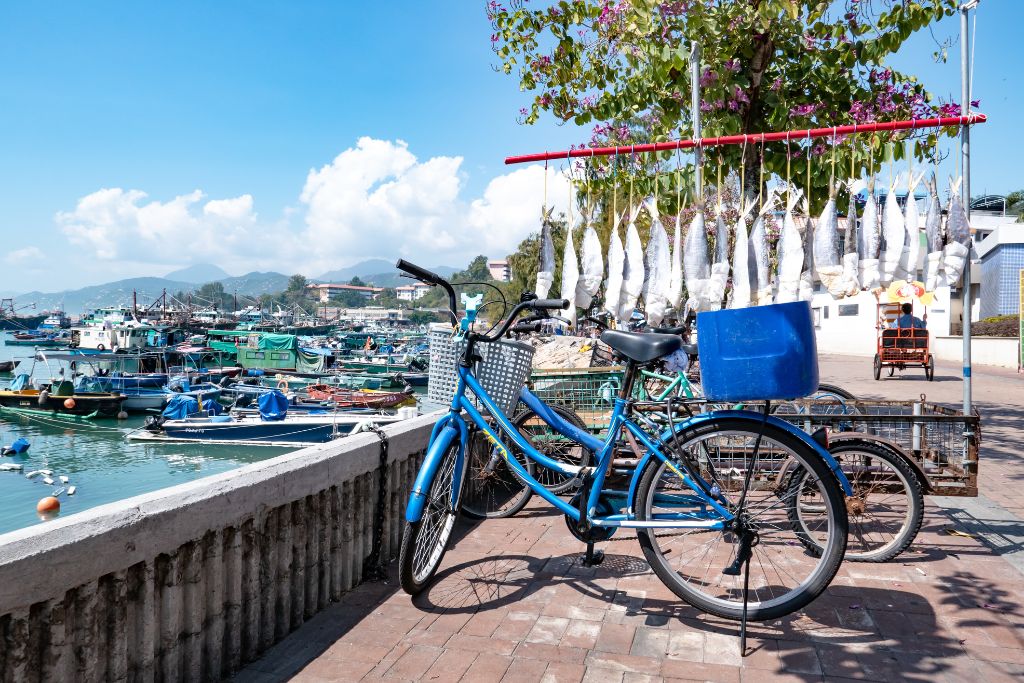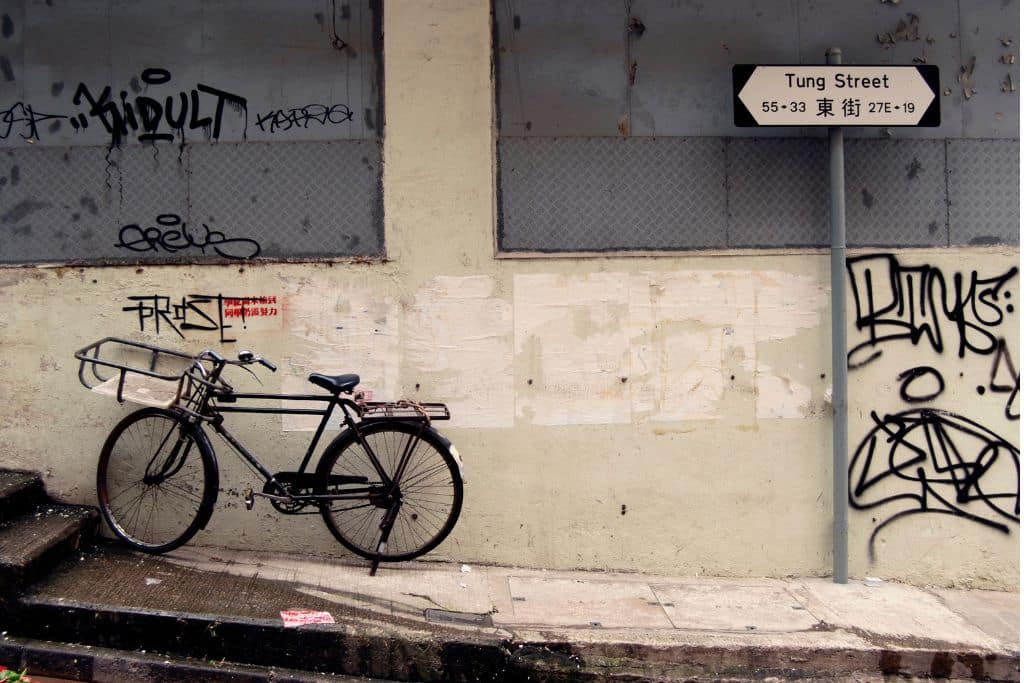Would Hongkongers entertain the idea of a bike-friendly Hong Kong? A couple of years ago, one writer opined that it would be “unlikely.” This is not an unjustified conclusion given that Hong Kong’s narrow roads and congested car lanes leave little space for bike lanes. Added to that, cyclists would have to navigate through hazardous traffic while inhaling exhaust fumes. Furthermore, the convenience and efficiency of Hong Kong’s public transport system make the prospect of biking less appealing. In part two of our two-part series on Hong Kong’s bike-friendliness, Curtis Lam takes a look at the legitimacy of concerns over promoting the use of bicycles and explores how well Hong Kong is positioned to alleviate them.
—
Bike-friendliness refers to practices, policies, infrastructures and cultures that promote safe and effective cycling as a mode of daily transportation. It focuses on the overall traffic conditions, facilities, networks and systems that allow cyclists to commute safely alongside other forms of transportation like cars, buses, trams, and trucks.
Since Covid-19, governments have been rethinking their approaches to urban design. Consequently, about 400 cities, states and countries have reallocated spaces for people to cycle and walk more easily, efficiently and safely. Today, this shift is still happening. This is largely due to the realisation of well-evidenced benefits of bike-friendliness for cities, the nature of which can be broadly divided into four different categories: Health benefits, ecological benefits, spatial and mobility benefits, and finally, economic benefits.
Despite the overwhelming evidence supporting the case for bike-friendliness, there still appears to be reluctance to fully embrace its implications on Hong Kong’s roads. Ranking 84th out of 90 cities on “bike-friendliness”, it is clear that it is not really on the government’s agenda for Hong Kong to embrace cycling even as a legitimate mode of transportation. Of course, there are factors that are beyond its control (like weather) but that is arguably only a small part of the equation.
Hongkongers are probably just as uninterested in the idea of cycling becoming a mode of transport but this might not necessarily be due to doubts about the credibility or validity of the evidence on bike-friendliness (given continued interest in cycling as a recreational activity in Hong Kong) but rather reservations about the generalisability of such findings to Hong Kong. They may apply to Europe, the US and other parts of Asia, but will they apply here?
Fair or Not? Hong Kong’s Aversion Toward Bikes
A number of questions have been raised about the utility of bike-friendly infrastructures in Hong Kong. While they are not entirely wrong, it is important to examine carefully what the underlying concerns are and whether those concerns are immovable obstacles or inconveniences that can be remedied. Here, we will try to break down some myths surrounding the (in)feasibility of bike-friendliness in Hong Kong.
1. Hong Kong is too hilly for daily cycling
Most experts suggest that an uphill gradient acceptable for bicycle use should be below 3%. Yet, Hong Kong is known for its extremely mountainous topography. While that may be true, it is arguably only true to a certain extent.
The first (and more obvious) solution to that would be to incentivise the use of e-bikes. Taking up a significant share of the heavy work involved in cycling, e-bikes have been “game-changers” in various parts of Europe, particularly for “less sporty people” and “senior citizens”. Today, e-bikes are banned from most roads in Hong Kong, but with the Transport Department’s recent green light for e-bikes and e-scooters in two areas – Tseung Kwan O and Pak Shek Kok – it seems that the support for their use is growing, both in public and policy circles.
Mechanical elevation systems are another way forward and are used all over Europe and also in parts of South Korea and Japan, despite being notoriously expensive to construct and maintain. Given how much space they take up, there is also literally no room for them in Hong Kong. Despite this downside, they should not necessarily be ruled out if cycling indeed becomes popular in Hong Kong.
There is still at least one more option. In many hilly cities like Lisbon, Brussels, Madrid, and Berlin, apps have been developed to plan and calculate for cyclists the flattest routes possible and thus facilitate cyclists’ navigation experience. Such apps would be very relevant in Hong Kong, and there would be little difficulty introducing them to the city’s roads.
In fact, while Hong Kong’s hilly terrain is no joke, most of the city’s developed areas – 25% of which is the result of reclamation projects – are flat land. In other words, most of the urban areas that Hongkongers use on a day-to-day basis are suitable for cycling. The challenge is whether they can be made bike-friendly.
2. Hong Kong’s roads are too narrow
Given the limited road space Hong Kong is already suffering from, how are we meant to create additional cycling lanes in Hong Kong?
Cycling lanes need not always be “carved out” of roads and pavements do not necessarily need to be “eaten away” to make space for them. For example, bus lanes can be converted into bus-and-bike lanes while simultaneously acting as buffer zones to help maintain traffic flow. This is a very common urban planning strategy in parts of the UK, especially when there are only two lanes.
The concern about narrow roads is not always about the narrowness of the roads themselves. In some parts of the New Territories, cyclists can simply cycle with cars on the same lane. Rather, it is often the speed of the traffic that matters, as it affects the degree to which cyclists are comfortable turning into a busy road or cutting lanes. This is why adjustments to speed limits are often implemented, and they have indeed done great wonders for cyclists, even when there are no dedicated bike lanes.
Speed adjustments are not new to Hong Kong. Streets near school zones, residential areas, or hospitals have always been subject to such arrangements for the benefit of road users.
James Ockenden, founder and editor of Transit Jam, a local newspaper dedicated to promoting clean, liveable streets and safe traffic in Hong Kong, argues that the problem is not that roads are too narrow but rather that a lot of our road spaces have been taken away by illegal parking. It is obstruction, rather than narrowness, therefore, that makes cycling such an unattractive option in Hong Kong, Ockenden argues. If such inconsiderate behaviour can be properly discouraged and reduced, Hong Kong’s lanes can indeed accommodate bikes.
Engineer Ranty Highwayman wrote on Twitter: “The street is not too narrow, [our] imagination is.”
3. Hong Kong’s poor air quality and weather deters anyone from wanting to cycle in urban areas
It is commonly argued that cycling to work can free individuals “from the confines of germ-infused buses and trains.” However, Hong Kong’s roads are just as detrimental to our lungs. Being a pedestrian is tough enough; imagine being stuck in traffic without anything to protect you the fumes. This is compounded by the fact that Hong Kong’s hot summers and unpredictable rainfall patterns make cycling a precarious mode of transport.
Researchers have admitted this caveat in the past. One study showed that cycling can increase travellers’ exposure to air pollutants (e.g. road dust, exhaust fumes), while another analysis demonstrated that, as cycling is an active form of transport, higher breathing rates (compared to walking or motorcycling) further increase the inhaled concentration of such harmful particles. Surely the cycling experience in Hong Kong would be just as bleak. However, all is not lost.
Both studies caution urban planners against simplistic solutions like encouraging cyclists to avoid peak hour travel (which is not enough since pollutants do not just disappear with traffic and are usually suspended in those areas even after peak hours), though they agree that there are simple measures that can help mitigate their effects. One example would be to put more effort into cleaning the roads, such as increasing the frequency of wet sweeping.
In the long run, intelligent design is what makes things possible. For example, bike lanes can be separated from main routes by “green belts” composed of specialised plants to limit dust resuspension. This is not only beneficial for air quality but also for cyclist safety.
Unfortunately, there is no perfect way to protect one against unpredictable rainfall and high temperatures in Hong Kong – and nobody would want to go into an office drenched in sweat or rain. This is why advocates of bike-friendliness know that cars and other forms of public transport are indispensable. However, it really only takes a minute to check the weather conditions to see whether cycling is fine for the day – if not, then the bus is always an option.
Very often, riding a bike creates a natural breeze, even during hot summers. When paired with the right clothing (e.g. bike clothing and raincoats) and accessories (e.g. phone mounts and bike umbrellas), cycling can be a lot more bearable than it seems.
You might also like: 6 Biggest Environmental Issues in Hong Kong in 2023
4. Hong Kong’s existing public transport system is already very well-developed
Hong Kong’s public transport infrastructure is commonly regarded as one of the best in the world. This also raises the question of whether it is cost-effective to create additional infrastructure to support harbour crossing for cycles, which would come with significant construction costs.
There are two main responses to these claims. Firstly, the fact that Hong Kong’s transport systems are advanced and efficient does not necessarily mean they cannot be improved. Both the congestion that drivers experience and the serious overcrowding on public transport (like the MTR) on a daily basis remain serious problems.
Bike-friendly road designs are one of the many possible solutions available. Cycling offers a range of flexibility benefits. For example, cyclists can manoeuvre through traffic like motorcyclists or switch to walking when necessary, unlike tram or bus passengers who must wait indoors. In situations where cycling alone is not possible, commuters can still rely on bicycles to cover the first or last mile to and from transit stations, like bus stops or MTR stations.
Secondly, even if, after careful assessment, policymakers decide that the construction of overhead cycleways, bike bridges, and tunnels to connect both sides of the harbour is too costly both economically and environmentally, it does not render cycling irrelevant.
Dr. Winnie Tang, professor at the University of Hong Kong (HKU), notes that “over half of Hong Kong Island residents (nearly 360,000 people) work on the island, and one-sixth of employees in Hong Kong work in the same district where they reside.” This means that, even without cross-harbour biking infrastructure in place, many Hongkongers may still benefit from cycling.
Urban planners do not have to worry about low bike lane usage rates in Hong Kong. On the topic of cycling infrastructure in Europe, Veronica Penney, climate reporter for the New York Times, wrote: “If you build it, they will bike.” A nice-sounding slogan that is also properly backed up by research. One study conducted by the City University of Hong Kong showed that the presence of cycling paths and facilities is positively associated with both commuting cycling and general cycling. In Hong Kong, the new Tseung Kwan O Cross Bay Link is a perfect illustration of this point.
Adding bike-friendly infrastructure does not imply the need to do away with Hong Kong’s existing public transport systems. Instead, its purpose would be to help alleviate the immense burdens currently placed on public transport by providing an extra mobility option for individuals who want to and can afford to have a bit more flexibility in their travels.
5. Hongkongers have no patience for other road users, let alone cyclists
The numbers palpably testify to this exclusion: Between 1998 and 2017, Hong Kong saw an average annual increase rate in cycling injuries of 5.18%, and by 2017, cyclists were more than two times more likely to be involved in traffic crashes than in 1998.
Compared to other regions, Hong Kong has one of the highest fatality rates for cycling. Road users are just not well enough educated on how to interact safely with cyclists. Similarly, cyclists who are not so familiar with road usage guidelines might indeed pose a threat to drivers, for example, if they do not know how to signal turns or when they intend to slow down.
Our road systems have been primarily designed to cater to motor vehicles, which has resulted in drivers feeling a sense of entitlement to “own” the road. Unfortunately, this has led to a perception among some that cyclists are intruders rather than legitimate users of public roads, despite the government explicitly acknowledging that “a cycle is regarded as a vehicle.” Consequently, cyclists are frequently expected to yield to drivers, and their safety is often overlooked.
While Hong Kong’s entrenched “bike-averse” culture and bad driving habits may be the hardest to tackle out of all the concerns mentioned thus far, how do we get a whole city to relearn her transport culture? Road safety campaigns have always been here, but how can they be more effective?
It is often said that meaningful and genuine transformation of culture must occur before structures can be changed. However, cultural shifts can also occur as a result of behavioural shifts. This can be achieved by “manipulating” driver biases through micro-adjustments to the way roads are viewed and used, which gradually re-engineer the attitudes and tendencies of road users. For instance, painting eye-catching markings such as zigzag lines at junctions that progressively get narrower to create the illusion of speeding up can prompt drivers to slow down and resist the temptation to run red or amber lights. Such effects have been shown to persist over time, even after the markings are removed.
In fact, many of the desired outcomes can be achieved through simple measures such as adding road signs, changing road markings, implementing speed limits, adjusting traffic light timings, establishing part-time cycling zones (similar to pedestrian schemes), and, in some cases, converting two-way roads into one-way roads. These changes can be made without the need for large sums of money or the mobilisation of hordes of bulldozers or dump trucks to dig up and rebuild all of our roads from scratch.

Adding bike-friendly infrastructure would help alleviate the immense burdens currently placed on public transport by providing an extra mobility option for individuals who want to and can afford to have a bit more flexibility in their travels. Image: Wikimedia Commons.
Promoting Bicycle Urbanism: Just Like Making Friends
As writer Charlie Sorrel puts it: “Bike lanes don’t get really effective unless you build enough of them… Only when there are enough lanes that people can ditch their cars and start commuting by bike do things really change for the better.”
Just like making friends, bike-friendliness needs more than just surface-level popularity to truly take off. What is needed is not simply the popularisation of the idea of bike-friendliness but also a series of strategies and plans to back it up in order for the idea to truly gain proper momentum and crystallise. We can have thousands of followers on social media but we might only consider a select few of them as true friends, because they are the ones who know how to and can actually be there for us when we need them.
Addressing our misconceptions about bike-friendliness does not automatically provide a strong case for incorporating bike-friendly designs into our city, as there are many other concerns and counterarguments that can be made (in particular, ones pertaining to logistics) which are beyond the scope of discussion here. However, it is still possible to notice that some of our worries about cycling as a form of transportation in Hong Kong may have been overstated. Hopefully, this can be a way to revive the conversation about creating a more bike-friendly Hong Kong – it is always better to start somewhere than not at all.
This article is Part 2 of a two-part series on Hong Kong’s bike-friendliness. Check out Part 1: Hong Kong Is Missing Out on ‘Bike-Friendliness’


















